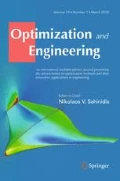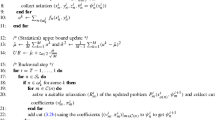Abstract
A bipartite bilinear program (BBP) is a quadratically constrained quadratic optimization problem where the variables can be partitioned into two sets such that fixing the variables in any one of the sets results in a linear program. We propose a new second order cone representable (SOCP) relaxation for BBP, which we show is stronger than the standard SDP relaxation intersected with the boolean quadratic polytope. We then propose a new branching rule inspired by the construction of the SOCP relaxation. We describe a new application of BBP called as the finite element model updating problem, which is a fundamental problem in structural engineering. Our computational experiments on this problem class show that the new branching rule together with an polyhedral outer approximation of the SOCP relaxation outperforms a state-of-the-art commercial global solver in obtaining dual bounds.







Similar content being viewed by others
References
Al-Khayyal FA, Falk JE (1983) Jointly constrained biconvex programming. Math Oper Res 8(2):273–286
Belotti P, Lee J, Liberti L, Margot F, Wächter A (2009) Branching and bounds tightening techniques for non-convex MINLP. Optim Methods Softw 24(4–5):597–634
Ben-Tal A, Nemirovski A (2001) Lectures on modern convex optimization: analysis, algorithms, and engineering applications. SIAM, Philadelphia
Bodur M, Del Pia A, Dey SS, Molinaro M, Pokutta S (2017) Aggregation-based cutting-planes for packing and covering integer programs. Math Program 171:331–359
Boland N, Dey SS, Kalinowski T, Molinaro M, Rigterink F (2017) Bounding the gap between the mccormick relaxation and the convex hull for bilinear functions. Math Program 162(1–2):523–535
Burer S, Letchford AN (2009) On nonconvex quadratic programming with box constraints. SIAM J Optim 20(2):1073–1089
Burer S, Kim S, Kojima M (2014) Faster, but weaker, relaxations for quadratically constrained quadratic programs. Comput Optim Appl 59(1):27–45
Castro PM (2015) Tightening piecewise mccormick relaxations for bilinear problems. Comput Chem Eng 72:300–311
Crowder H, Johnson EL, Padberg M (1983) Solving large-scale zero-one linear programming problems. Oper Res 31(5):803–834
Davarnia D, Richard J-PP, Tawarmalani M (2017) Simultaneous convexification of bilinear functions over polytopes with application to network interdiction. SIAM J Optim 27(3):1801–1833
Dey SS, Gupte A (2015) Analysis of milp techniques for the pooling problem. Oper Res 63(2):412–427
Dey SS, Molinaro M, Wang Q (2017) Analysis of sparse cutting planes for sparse milps with applications to stochastic milps. Math Oper Res 43:304–332
Faria DC, Bagajewicz MJ (2011) Novel bound contraction procedure for global optimization of bilinear minlp problems with applications to water management problems. Comput Chem Eng 35(3):446–455
Galan B, Grossmann IE (1998) Optimal design of distributed wastewater treatment networks. Ind Eng Chem Res 37(10):4036–4048
Gorski J, Pfeuffer F, Klamroth K (2007) Biconvex sets and optimization with biconvex functions: a survey and extensions. Math Methods Oper Res 66(3):373–407
Gupte A (2011) Mixed integer bilinear programming with applications to the pooling problem. Ph.D. thesis, Georgia Institute of Technology
Gupte A, Ahmed S, Dey SS, Cheon M-S (2017) Relaxations and discretizations for the pooling problem. J Global Optim 67(3):631–669
Gupte A, Kalinowski T, Rigterink F, Waterer H Extended formulations for convex hulls of graphs of bilinear functions (Unpublished)
Haverly CA (1978) Studies of the behavior of recursion for the pooling problem. Acm Sigmap Bull 25:19–28
Hillestad RJ, Jacobsen SE (1980) Linear programs with an additional reverse convex constraint. Appl Math Optim 6(1):257–269
Kim S, Kojima M (2001) Second order cone programming relaxation of nonconvex quadratic optimization problems. Optim Methods Softw 15(3–4):201–224
Kocuk B, Dey SS, Andy SX (2017) Matrix minor reformulation and socp-based spatial branch-and-cut method for the ac optimal power flow problem. arXiv preprint arXiv:1703.03050
Linderoth J (2005) A simplicial branch-and-bound algorithm for solving quadratically constrained quadratic programs. Math Program 103(2):251–282
Luedtke JR, Namazifar M, Linderoth J (2012) Some results on the strength of relaxations of multilinear functions. Math Program 136(2):325–351
Marchand H, Wolsey LA (2001) Aggregation and mixed integer rounding to solve mips. Oper Res 49(3):363–371
Meyer CA, Floudas CA (2005) Convex envelopes for edge-concave functions. Math Program 103(2):207–224
Meyer CA, Floudas CA (2006) Global optimization of a combinatorially complex generalized pooling problem. AIChE J 52(3):1027–1037
Misener R, Floudas CA (2014) ANTIGONE: algorithms for coNTinuous/integer global optimization of nonlinear equations. J Global Optim 59(2–3):503–526
Nahapetyan AG (2008) Bilinear programming: applications in the supply chain management bilinear programming: applications in the supply chain management. In: Floudas CA, Pardalos PM (eds) Encyclopedia of optimization. Springer, Berlin, pp 282–288
Nguyen TT, Tawarmalani M, Richard J-PP (2011) Convexification techniques for linear complementarity constraints. In: IPCO, vol 6655. Springer, pp 336–348
Nguyen TT, Richard J-PP, Tawarmalani M (2013) Deriving the convex hull of a polynomial partitioning set through lifting and projection. Technical report, working paper
Nguyen TT, Richard J-PP, Tawarmalani M (2018) Deriving convex hulls through lifting and projection. Math Program 169(2):377–415
Padberg M (1989) The boolean quadric polytope: some characteristics, facets and relatives. Math Program 45(1–3):139–172
Rahman H, Mahajan A (2017) Facets of a mixed-integer bilinear covering set with bounds on variables. arXiv preprint arXiv:1707.06712
Rikun AD (1997) A convex envelope formula for multilinear functions. J Global Optim 10(4):425–437
Ryoo HS, Sahinidis NV (1996) A branch-and-reduce approach to global optimization. J Global Optim 8(2):107–138
Sahinidis NV, Tawarmalani M (2005) Accelerating branch-and-bound through a modeling language construct for relaxation-specific constraints. J Global Optim 32(2):259–280
Speakman E, Lee J (2017) On branching-point selection for triple products in spatial branch-and-bound: the hull relaxation. arXiv preprint arXiv:1706.08438
Tawarmalani M, Richard J-PP (2013) Decomposition techniques in convexification of inequalities. Technical report
Tawarmalani M, Sahinidis NV (2002) Convexification and global optimization in continuous and mixed-integer nonlinear programming: theory, algorithms, software, and applications, vol 65. Springer, Berlin
Tawarmalani M, Richard J-PP, Chung K (2010) Strong valid inequalities for orthogonal disjunctions and bilinear covering sets. Math Program 124(1):481–512
Tawarmalani M, Richard J-PP, Xiong C (2013) Explicit convex and concave envelopes through polyhedral subdivisions. Math Program 138:1–47
Tuy H (2016) Convex analysis and global optimization, vol 110. Springer, Berlin
Vigerske S, Gleixner A (2018) SCIP: global optimization of mixed-integer nonlinear programs in a branch-and-cut framework. Optim Methods Softw 33(3):563–593
Zhu D, Dong X, Wang Y (2016) Substructure stiffness and mass updating through minimization of modal dynamic residuals. J Eng Mech 142(5):04016013
Acknowledgements
The authors would like to thank Xinjun Dong in Civil and Environmental Engineering at Georgia Tech, for his assistance with preparing the structural example data. Santanu S. Dey would like to acknowledge the discussion on a preliminary version of this paper at Dagstuhl workshop #18081, that helped improve the paper.
Funding
This work was supported by the NSF CMMI [Grant No. 1149400]; the NSF CMMI [Grant No. 1150700]; and the CNPq-Brazil [Grant No. 248941/2013-5].
Author information
Authors and Affiliations
Corresponding author
Rights and permissions
About this article
Cite this article
Dey, S.S., Santana, A. & Wang, Y. New SOCP relaxation and branching rule for bipartite bilinear programs. Optim Eng 20, 307–336 (2019). https://doi.org/10.1007/s11081-018-9402-9
Received:
Revised:
Accepted:
Published:
Issue Date:
DOI: https://doi.org/10.1007/s11081-018-9402-9




